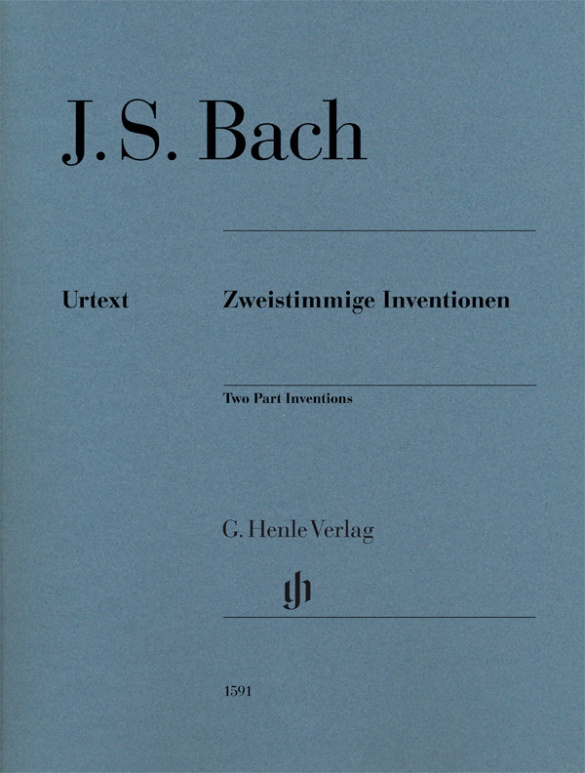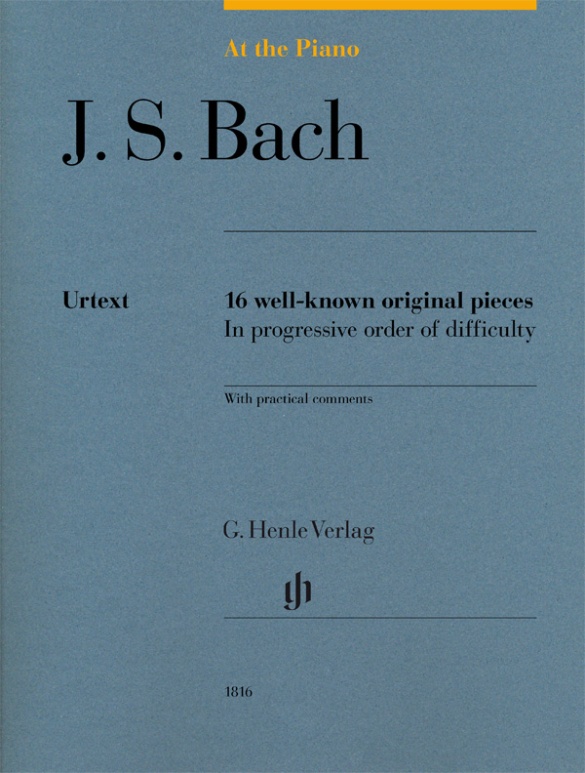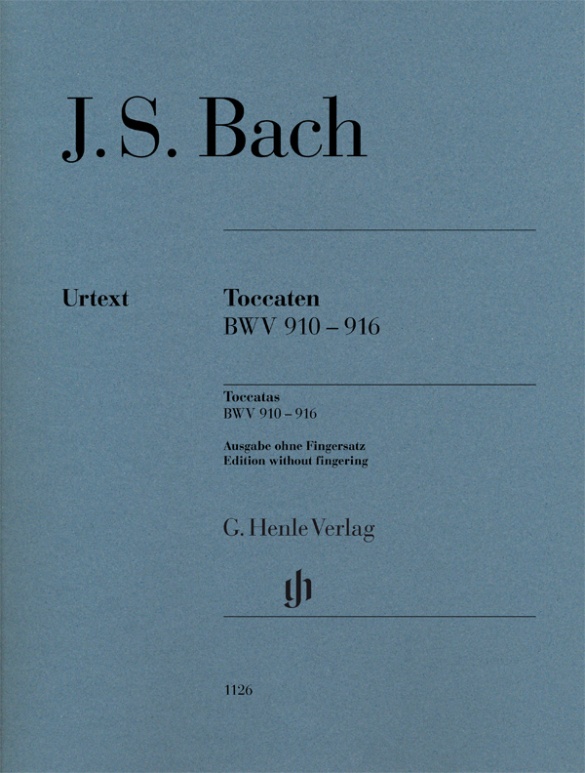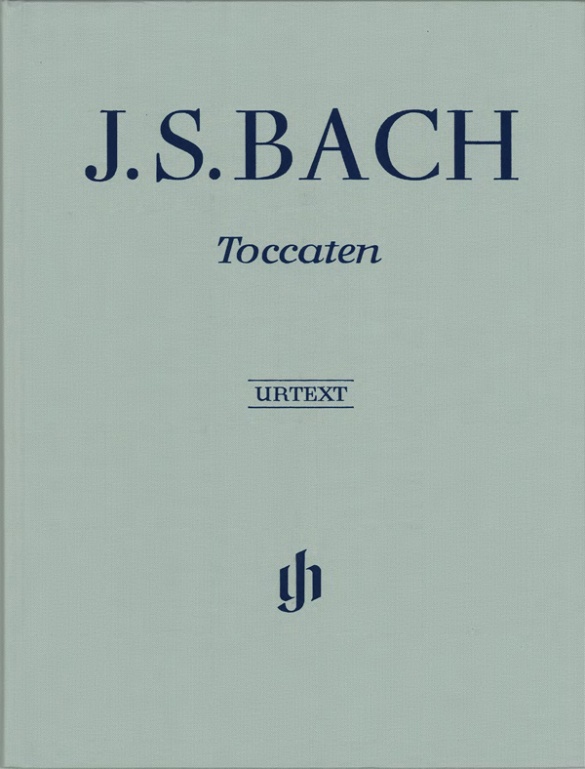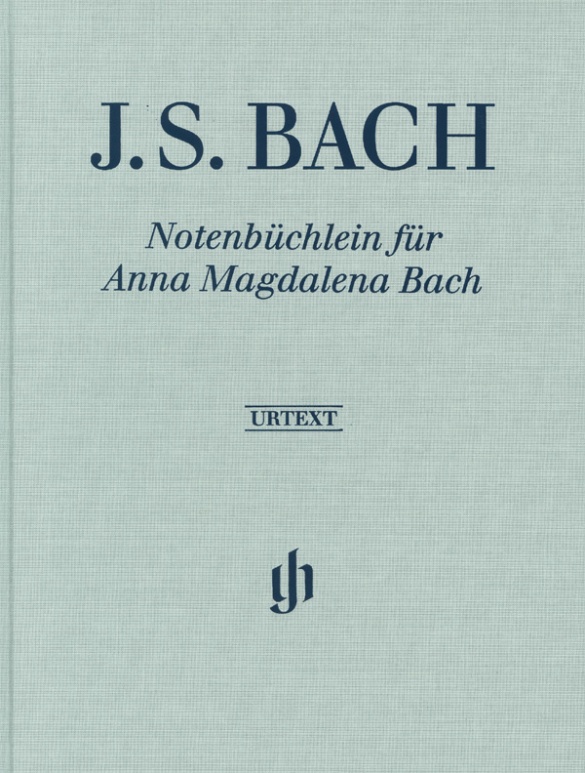

Johann Sebastian Bach
Petit livre pour Anna Magdalena Bach
Bach fit cadeau de deux recueils manuscrits de partitions à sa femme Anna Madgdalena. Par sa reliure recouverte de parchemin et dorée sur tranche, le second est particulièrement précieux. Dans ce petit recueil (Büchlein) daté de 1725, il nota un grand nombre de pièces de sa propre plume, ou de celle d’autres compositeurs, destinées au clavier et dans tous les genres. Figurant chaque année au palmarès des titres les plus vendus de notre catalogue, l’édition Urtext parue chez Henle rend, gravé de manière remarquable à la main et de la manière la plus fidèle, l’intégralité de ce manuscrit, à l’exception des mouvements extraits des «Suites françaises» (HN 593) et des «Partitas» (HN 28) figurant également dans le Notenbüchlein, qui eux, comme chacun sait, se trouvent ailleurs dans notre catalogue.
CONTENU/DÉTAILS
(Explanation)
CONCERNANT LE COMPOSITEUR
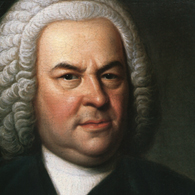
Johann Sebastian Bach
Il est le compositeur le plus adopté depuis la fin du 18e siècle; ses compositions, densément structurées, dépassent en qualité celles de ses contemporains. Les genres musicaux qu’il aborde sont déterminés par les emplois qu’il a exercés. En tant qu’organiste à Mühlhausen et Weimar il compose en premier lieu de la musique d’orgue. Plus tard, en tant que maître de chapelle à Köthen et chef du Collegium musicum de Leipzig, des concertos et de la musique chambre. Enfin, durant les décennies de son activité de cantor à Leipzig, ce sont avant tout des compositions vocales sacrées. Ses compositions plus tardives, au contrepoint complexe, se dérobent aux courants contemporains, notamment au style préclassique, plus léger.
| 1685 | Né le 21 mars à Eisenach, fils du maître de chapelle et musicien de cour Johann Ambrosius Bach. |
| 1693–95 | Fréquente l’école latine d’Eisenach. |
| 1695–1700 | Fréquentation du lycée à Ohrdruf, où il vit chez son frère aîné Johann Christoph après le décès de ses parents; entre autres organiste et élève de Pachelbel. |
| à partir de 1700 | Membre du Mettenchor de Lüneburg. Voyages à Hambourg pour écouter l’organiste Reincken. |
| 1703 | Engagé à Weimar pour deux trimestres (auprès du prince Johann Ernst l’Ancien). |
| 1703–07 | Organiste à Arnstadt. Composition d’œuvres pour orgue, peut-être les tout premiers Préludes et fugues BWV 531, 549a, 575, les chorals de la collection Neumeister BWV 1090–95, 1097–1120, les «Partitas sur des chorals» BWV 766–768, 770. |
| 1705 | Voyage à Lübeck pour rencontrer Buxtehude. |
| 1707–08 | Engagement comme organiste à l’église Saint-Blaise de Mühlhausen. Composition de ses premières cantates (BWV 71 et 131, probablement aussi BWV 4, 106, 150, 196). |
| 1708–17 | Engagement en tant qu’organiste à Weimar auprès du duc Wilhelm Ernst von Sachsen-Weimar; composition de l’Orgelbüchlein BWV 599–644, de préludes (toccatas, fantaisies) et de fugues (probablement BWV 894, 903, 944, 910–916), de la Passacaille en Ut mineur BWV 582, de la «Pièce d’orgue» en Sol majeur BWV 572; transcription pour orgue de concertos instrumentaux, entre autres «L’estro armonico» de Vivaldi. |
| à partir de 1714 | Konzertmeister, composition de cantates. |
| 1710 | Naissance de Wilhelm Friedemann Bach. |
| 1714 | Naissance de Carl Philipp Emanuel Bach. |
| vers 1713 | création à Weißenfels de la cantate «Was mir behagt, ist nur die muntre Jagd!» (Cantate de la chasse) BWV 208. |
| 1717–23 | Engagement à Köthen auprès du prince Leopold von Anhalt-Köthen en tant que «Hofkapellmeister und Direktor der fürstlichen Kammermusiken» (maître de chapelle et directeur de la musique de chambre princière). Il compose principalement de la musique pour clavier (achèvement des Suites anglaises BWV 806–811, commence vers 1722 la composition des Suites françaises BWV 812–817, Klavierbüchlein pour Wilhelm Friedemann Bach à partir de 1720, « Le Clavier bien tempéré » 1re partie en 1722, entreprend à partir de 1722 le 1er Klavierbüchlein pour Anna Magdalena Bach, Inventions et Sinfoniae pour clavier (BWV 772–801, 1723), musique de chambre (Sonates et Partitas pour violon solo BWV 1001–1006, 1720), concertos (Concertos brandebourgeois BWV 1046–1051, dédiés au margrave de Brandebourg, 1721) ; quelques rares cantates profanes (entre autres BWV 134a, 173a). |
| 1723–50 | Cantor à l’église Saint-Thomas de Leipzig. |
| 1723–29 | Première période à Leipzig, principalement dominée par des compositions de musique sacrée. |
| 1723/24 | Premier cycle annuel de cantates: intégration des cantates composées à Weimar et à Köthen. Mise en œuvre du procédé de parodie consistant à remplacer les textes à de nouvelles fins. |
| 1724 | Exécution de la Passion selon saint Jean BWV 245 et du Magnificat BWV 243a. |
| 1724/25 | Deuxième cycle annuel de cantates avec de nouvelles compositions. |
| 1726 | Impression de la 1re Partita de la future Clavierübung BWV 825–830. |
| 1727 | Exécution de la Passion selon saint Matthieu BWV 244. |
| 1729–39 | Seconde période à Leipzig, marquée par la direction du Collegium musicum fondé par Telemann (1729-1737 et 1739 jusqu’à 1741 au moins) et, de ce fait, par la composition d’œuvres instrumentales ainsi que de grandes œuvres vocales. |
| vers 1730 | 6 Sonates en trio pour orgue (BWV 525–530), importants Préludes et Fugues (Si mineur BWV 544, Ut majeur BWV 547, Mi mineur BWV 548). |
| à partir de/vers | 1730 Mise au point d’un nouveau type de concerto avec des concertos pour 1 à 4 clavecins (qui sont presque tous des transcriptions de concertos pour instruments mélodiques). Autres compositions pour ensembles instrumentaux. |
| 1731 | Exécution de la Passion selon saint Marc BWV 247 (perdue). Voyage à Dresde à l’occasion de l’exécution d’un opéra de Hasse. Clavierübung 1re partie BWV 825–830. |
| 1733 | Composition d’une messe luthérienne (Kyrie et Gloria) dont les mouvements seront repris plus tard dans la Messe en Si mineur BWV 232; offerte au prince électeur Friedrich August II à Dresde dans l’espoir d’obtenir un titre de noblesse. |
| 1734/35 | Création de l’Oratorio de Noël BWV 248. |
| 1735 | Oratorio de l’Ascension BWV 11. Naissance de Johann Christian Bach. Clavierübung 2e partie BWV 971, 831. |
| 1736 | Friedrich August II lui octroie le titre de Compositeur de la cour. |
| vers 1738/39 | 4 Messes luthériennes BWV 233–236. |
| 1739-50 | Troisième phase à Leipzig. Elle est marquée par la composition de l’œuvre tardive caractérisée par un recours au style ancien et à des techniques contrapuntiques complexes. Point d’aboutissement de l’œuvre pour clavier de Bach. |
| 1739 | Clavierübung 3e partie BWV 802–805. |
| 1741 | Clavierübung 4e partie BWV 988 (Variations Goldberg). |
| 1739/42 | Clavier bien tempéré, 2e partie BWV 870–893. |
| 1747 | Voyage à Potsdam où il improvise une fugue sur un thème donné par le roi, qui est à l’origine de l’«Offrande musicale» BWV 1079. Membre de la «Correspondirende Societät der musicalischen Wissenschaften» (Société des sciences musicales) à laquelle il offre, en tant que membre, sa rédaction des Variations canoniques sur «Vom Himmel hoch, da homm ich her» BWV 988. Chorals Schübler BWV 645-650. |
| 1749 | Achèvement de la Messe en Si mineur qui repose en majeure partie sur des compositions antérieures, remaniées et complétées. |
| 1750 | «Art de la Fugue». Demeure inachevée. Meurt le 28 juillet à Leipzig. |
About the Authors
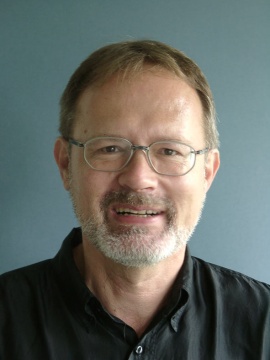
Ernst-Günter Heinemann (Editeur)
Dr. Ernst-Günter Heinemann, born in 1945 in Bad Marienberg (Westerwald), completed his schooling in Gießen and read musicology, philosophy and German in Marburg and Frankfurt/Main and also for some time Protestant church music. He did his doctorate on “Franz Liszts geistliche Musik. Zum Konflikt von Kunst und Engagement”.
From 1978–2010 Heinemann worked as an editor at G. Henle Publishers (in 1978 in Duisburg, from 1979 onwards in Munich). He edited a great many Urtext editions for the publishing house, including “Das Wohltemperierte Klavier”, Volume 1 by Bach and all of Debussy’s piano works. In addition, he wrote essays on Debussy, Grieg, Liszt, Mendelssohn and questions concerning general editing, as well as giving seminars on editorial practice for musicology students in Munich.
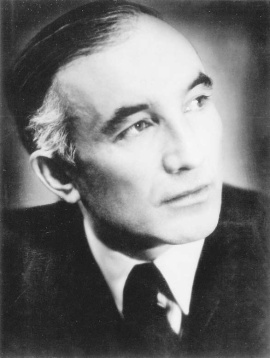
Hans-Martin Theopold (Doigtés)
Prof. Hans-Martin Theopold, was born to a pastor’s family in Detmold on 22 April 1904, the youngest of five children. Even as a child he often played the organ in the “Marktkirche” and soon began to take piano lessons with Theodor Vehmeier. At the age of 17 he made his debut at the Landestheater in Detmold with Ludwig van Beethoven’s Piano Concerto in C major under Friedrich Quast (Herford). Following the successful completion of his schooling at the Gymnasium Leopoldinum in Detmold, he went on to study music and piano (main subject): from 1922–23 at the “Württembergische Hochschule für Musik” in Stuttgart (with Max Pauer, 1866–1945) and then from 1923–1928 at the “Staatliche Akademische Hochschule für Musik” in Berlin-Charlottenburg (with Richard Rössler, 1880–1962, and Waldemar Lütschg, 1877–1948). After completing his piano studies (graduating with “very good”) in 1928, he began an active solo career both at home and abroad (USA, Switzerland, Scandinavia, the Baltic states, the Balkans). As a member of the Chamber Music Association of the State Opera in Berlin (from 1933) he also gave countless chamber music concerts, including ones with his violin partner Gustav Havemann (1882–1960).
In the 1930s, audiences and the press alike raved about Theopold’s extraordinary gifts as a pianist: “This young player has it in him to soon become one of the best players in Germany. A superior technique, a wonderful singing piano tone, the strength of a Titan, but not at all hard due to the incomparably gentle elasticity of his touch” [Münchener Zeitung, 21 November 1933]. – “H.M. Theopold gave convincing proof of his splendid pianistic ability in an extremely gripping sonata with a modern idiom by Alban Berg, but predominantly in Schubert’s […] Wanderer Fantasy, which he played with a polished technique and creative power” [Weser-Zeitung, 21 December 1932]. Theopold was awarded several prizes, including the “Grotrian-Steinweg-Preis” in 1928.
In 1937 Theopold became a teacher for the piano (main subject) at the “Bayerisches Staatskonservatorium der Musik” in Würzburg. In 1939 he married Irene Tatjana Wülfing, who was from Moscow. From 1943 he became head of the piano master-class at the “Nordische Musikschule” in Bremen, although this was interrupted by the events of the war. Following his return from a prisoner of war camp, Theopold gave concerts and taught although he did not hold a permanent position. From 1955–1956 he was acting head of the piano master-class at the “Bergisches Landeskonservatorium” in Wuppertal, finally being appointed Professor for Piano on 1 April 1956 at the “Staatliches Institut für Schul- und Volksmusik” in Detmold, later at the “Nordwestdeutsche Musikakademie Detmold” (today “Hochschule für Musik Detmold”), where he taught for decades. On 30 September 1969 he retired. “His students extol his pedagogical gifts. […] Humour, charm, helpfulness and kind-heartedness moderate the strictness of his professional ethos as a musician and teacher” (Lippische Rundschau, 23 April 1969; see also: Lippische Landeszeitung 22 April 1969 on the occasion of Theopold’s 65. birthday: “Prof. Theopold, a modest but at the same time energetic man, is an enthusiastic teacher”). Theopold died in Detmold in 2000.
Contact with Günter Henle was established directly after the publishing house was founded, when Theopold thanked the publishers with great enthusiasm for its first Urtext editions. His extensive correspondence with the publishing house was bequeathed to the Lippische Landesbibliothek in 2014 to ensure its long-term accessibility to the public. The letters testify not only to Theopold’s great interest in musical sources and text questions but also to his initial strict refusal (!) of fingerings in text-critical editions such as these: “For fingerings are and remain something individual no matter what their quality” (letter to Günter Henle from 26 May 1949 {publishing house archives}). Günter Henle was not, however, to be swayed and stressed the necessity of fingerings in his Urtext editions: “It is better to publish the Urtext […] with fingerings that are not necessary for a few individuals, or that might even, I admit, be considered irritating here and there” (letter to Hans-Martin Theopold of 17 September 1953).
It was only in 1955 that Theopold accepted Günter Henle’s offer of contributing fingerings for an Urtext edition that was in the process of being prepared by way of trial. (HN 74, Schubert, Complete Dances for Piano, Volume 1). Following this, Theopold was commissioned to write the fingerings for nearly all of the publishing house’s new editions in quick succession. Günter Henle, himself a good pianist, greatly valued Theopold’s fingerings, and also the many suggestions regarding the musical text in question. In addition, Theopold was always very reliable, thorough and conscientious – something that is not unimportant with editorial work!
Thus to date Hans-Martin Theopold has provided the fingerings for the greatest number of Henle Urtext editions by far – 226 editions (!) in total.
We would like to thank Mrs Margot Theopold and the Hochschule für Musik in Detmold for their great support in providing biographical material.
G. Henle Verlag
Informations sur la sécurité du produit

G. Henle Verlag
Vous trouverez ici des informations sur le fabricant du produit.G. Henle Verlag e.K.
Forstenrieder Allee 122
81476 München
Allemagne
info@henle.de
www.henle.com
recommandations
autogenerated_cross_selling
Autres éditions de ce titre
Autres éditions de ce titre


